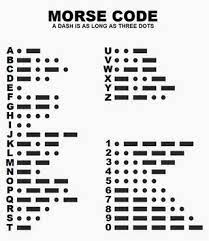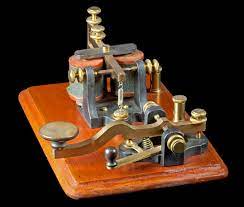Morse code was invented by an American called Samuel Finley Breese Morse, (1791-1872). He was not only an inventor but also a famous painter.
Student FREE Bookstore (CLICK HERE)
The History Of Morse Code
Introduction:
Morse code was invented by an American called Samuel Finley Breese Morse, (1791-1872). He was not only an inventor but also a famous painter. Did you know that knowing a little Morse code even today can be very useful. In fact, it may save your life one day. The international distress code is S, O, S, which means ‘save our souls’ in English. If you find yourself in trouble and your life is in danger, then knowing the S O S code can be very useful. An (S) is (…) and an (O) is (- – -). So three dots then three dashes then three dots is (SOS) . You could tap out the signal or use the flash light on your cellphone, especially if you don’t have a cellphone signal. … – – – … = SOS.
New Vocabulary: invented, a famous painter
Audio 1: To study listen to the audio and read at the same time.
Section One

Before the invention of the telegraph, most messages that had to be sent over long distances were carried by messengers who memorised them or carried them in writing. These messages could be delivered no faster than the fastest horse. Messages could also be sent visually, using flags and later, mechanical systems called semaphore telegraphs, but these systems required the receiver to be close enough to see the sender, and could not be used at night.
New Vocabulary: The Telegraph, long distances, memorised, delivered, the fastest horse visually, flags, mechanical systems, semaphore, telegraphs, receiver, sender
Audio 2: To study listen to the audio and read at the same time.
Section Two:
The telegraph allowed messages to be sent very fast over long distances using electricity. The first commercial telegraph was developed by William Forthergill Cooke and Charles Wheatstone in 1837. They developed a device which could send messages using electrical signals to line up compass needles on a grid containing letters of the alphabet. Then, in 1838, Samuel Morse and his assistant, Alfred Vail, demonstrated an even more successful telegraph device which sent messages using a special code – Morse code.
New Vocabulary: allowed, electricity, commercial, developed by, a device, electrical, signals, compass, compass needle, alphabet, his assistant, a special code
Audio 3: To study listen to the audio and read at the same time.
Section Three:
Telegraph messages were sent by tapping out the code for each letter in the form of long and short signals. Short signals are referred to as dits (represented as dots). Long signals are referred to as dahs (represented as dashes). The code (words) were converted into electrical impulses and sent over to the receiver and converted back into sounds. A telegraph receiver on the other end of the wire converted the impulses back into to dots and dashes, and decoded the message back into words. In 1844, Morse demonstrated the telegraph to the United States Congress using a now famous message “What hath God wrought”. SEE BELOW FOR DIFFERENT TRANSLATIONS.
New Vocabulary: by tapping out the code, long and short signals, dits, dahs, dashes, converted into electrical impulses, converted into electrical impulses dots and dashes, United States Congress, "What hath God wrought".
Audio 4: To study listen to the audio and read at the same time.
Old English Example translation: (The Lord’s Prayer) Our Father.
Fæder ure, ðu ðe eart (is) on heofenum, si ðin nama gehalgod, to-becume ðin rice, geweorþe ðin willa on eorðan swa swa on heofenum. Urne ge dæghwamlican hlaf syle us to-deag, and forgyf us ure gyltas, swa swa we forgifaþ urum gyltendum, ane ne gelæde ðu us on costnunge, ac alys us of yfle.
Modern English translation (The Lords Prayer) Our Father.
Our Father, which art (is) in heaven, Hallowed be thy (your) Name. Thy (your) Kingdom come. Thy will be done in earth, As it is in heaven. Give us this day our daily bread. And forgive us our trespasses, As we forgive them that trespass against us. And lead us not into temptation, But deliver us from evil. For thine (your’s) is the kingdom, The power, and the glory, For ever and ever. Amen.
Morse Code translation (The Lords Prayer) Our Father.
— — -.. . .-. -. / . -. –. .-.. .. … …. / – .-. .- -. … .-.. .- – .. — -. / -.–. – …. . / .-.. — .-. -.. … / .–. .-. .- -.– . .-. -.–.- / — ..- .-. / ..-. .- – …. . .-. .-.-.- / — ..- .-. / ..-. .- – …. . .-. –..– / .– …. .. -.-. …. / .- .-. – / .. -. / …. . .- …- . -. –..– / …. .- .-.. .-.. — .– . -.. / -… . / – …. -.– / -. .- — . .-.-.- / – …. -.– / -.- .. -. –. -.. — — / -.-. — — . .-.-.- / – …. -.– / .– .. .-.. .-.. / -… . / -.. — -. . / .. -. / . .- .-. – …. –..– / .- … / .. – / .. … / .. -. / …. . .- …- . -. .-.-.- / –. .. …- . / ..- … / – …. .. … / -.. .- -.– / — ..- .-. / -.. .- .. .-.. -.– / -… .-. . .- -.. .-.-.- / .- -. -.. / ..-. — .-. –. .. …- . / ..- … / — ..- .-. / – .-. . … .–. .- … … . … –..– / .- … / .– . / ..-. — .-. –. .. …- . / – …. . — / – …. .- – / – .-. . … .–. .- … … / .- –. .- .. -. … – / ..- … .-.-.- / .- -. -.. / .-.. . .- -.. / ..- … / -. — – / .. -. – — / – . — .–. – .- – .. — -. –..– / -… ..- – / -.. . .-.. .. …- . .-. / ..- … / ..-. .-. — — / . …- .. .-.. .-.-.- / ..-. — .-. / – …. .. -. . / .. … / – …. . / -.- .. -. –. -.. — — –..– / – …. . / .–. — .– . .-. –..– / .- -. -.. / – …. . / –. .-.. — .-. -.– –..– / ..-. — .-. / . …- . .-. / .- -. -.. / . …- . .-. .-.-.- / .- — . -. .-.-.- MORSE CODE TRANSLATOR CLICK HERE
Listen to the Morse Code for the Lords Prayer:
Video Listening Section: Watch the video and then answer the six questions below.
Questions:
-
-
-
- When was Morse code invented?
-

Steve’s Blog: CLICK HERE What could this system of communication detect?
- In the video the boy says, ” Morse code could either be ‘sped-up’ or slowed down.” What does ‘sped-up’ mean?
- When did Samuel Morse send his first message by Morse code?
- After Samuel Morse, who invented the ‘wireless’ telegraph and where was the first wireless message sent from?
- In Morse code, what is the international distress code?
-
-
What does this code say? Use the Morse Code chart above to calculate the message.
Translate this code
.. / .-.., – – -, …-, . / …, -, ., …-, ., … / .-.., ., …, …, – – -, -., …
NOTE: How did you do? Did you complete the task in five miinutes? Remember that we have discussed that e(.) and I(..) and s(…) and o(- – – ). So let’s look at the task again
‘I _ o _ e S _ e _ e’ s _ e s s o _ s’
Section Four:
One of Morse’s aims was to keep the code as short as possible, which meant the commonest letters should have the shortest codes. Morse came up with a marvellous idea. He went to his local newspaper. In those days printers made their papers by putting together individual letters (type) into a block, then covering the block with ink and pressing paper on the top. The printers kept the letters (type) in cases with each letter kept in a separate compartment. Of course, they had many more of some letters than others because they knew they needed more when they created a page of print. Morse simply counted the number of pieces of type for each letter. He found that there were more e’s than any other letter and so he gave ‘e’ the shortest code, ‘dit’. This explains why there appears to be no obvious relationship between alphabetical order and the symbols use. 
New Vocabulary: aims, meant, commonest, marvellous, a block, ink, printers, a separate compartment, appears to be, relationship, alphabetical order, symbols
Audio 5: To study listen to the audio and read at the same time.
Writing Section:
Write a short message to your teacher about wanting to change your time for the next lesson first in Portuguese, then in English and finally in Morse cade.
Grammar:
In your writing in the English section include two examples of the present perfect and three transition words. See the link below to help you: TRANSITION WORDS LINK




